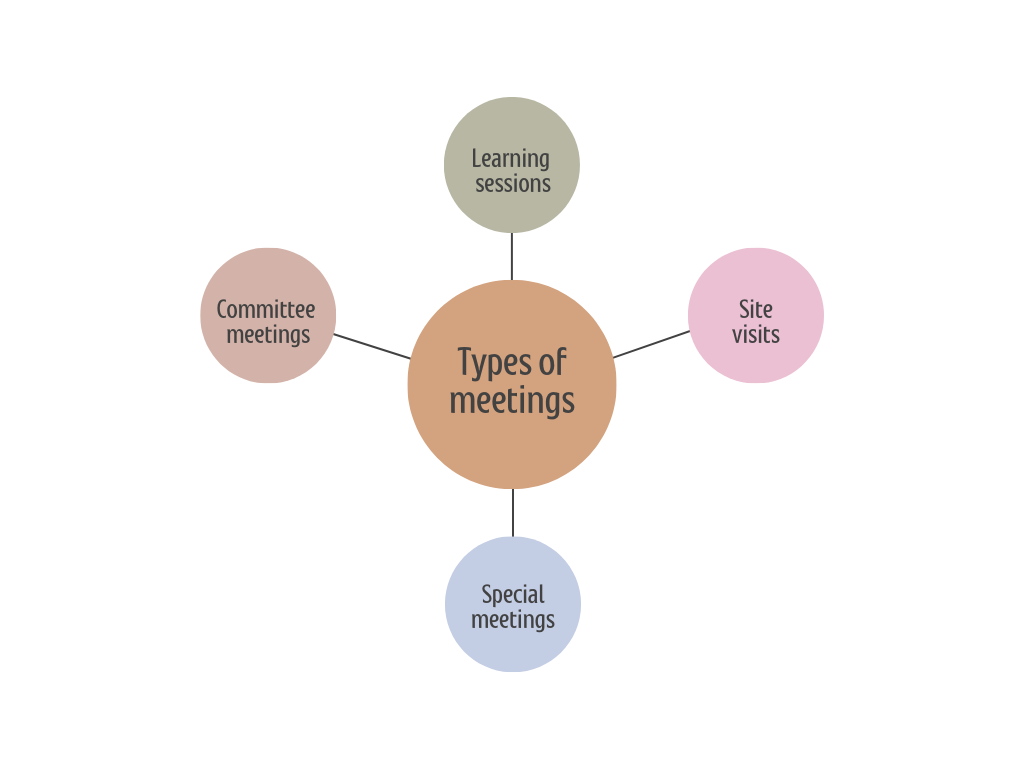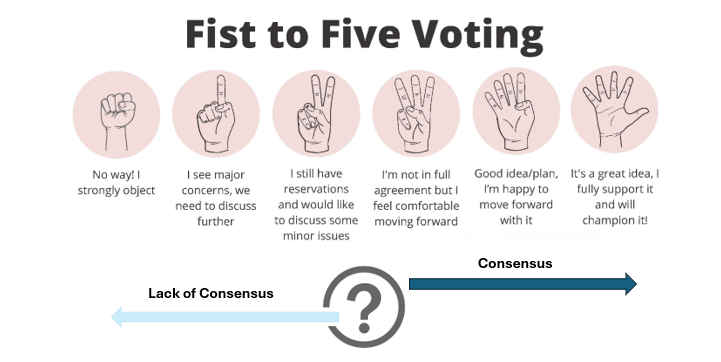The Impact of Effective Meetings on Communication, Trust, and Wealth Management
A Practical Guide for Philanthropic Families
Effective family meetings play a crucial role in the family governance process. These gatherings serve as a platform for open discussions, information sharing, continuous learning, and collaborative decision-making. The primary objective of family meetings is to enhance communication, foster trust, and strengthen connections within the family, employing a structured approach with defined goals and active engagement.

Why are Family Meetings Important
Ultimately, these meetings contribute to the cultivation of family unity and the responsible management of wealth. Additionally, they provide an excellent opportunity to instill a philanthropic spirit among family members, encouraging them to collectively identify and support charitable causes that align with the family’s values.
Family meetings are a great opportunity for multi-generational engagement and can offer a space for emerging next-gen leaders to play new and expanding roles too. Simple activities such as brief paired conversations with a prompt question can allow different family members to hear from one another in new ways and create a smaller scale environment for younger family members to begin to use their voice at the philanthropic table.
Moreover, family meetings provide a platform to address significant matters impacting one or more family members and facilitate the exchange of expertise or knowledge across various subjects, such as planning, legacy, individual and collective family objectives, and aspirations.
During these gatherings, some families create family values and vision statement, exploring beliefs about life and family while addressing common issues. At Callan Capital we have created a Workbook for Family Philanthropy to help our clients shape their Charitable Mission Statements and Charitable Giving Policies, the latter of which includes establishing frameworks for regular family meetings.
What’s the Role of a Family Mission Statement
A good place to start can be stating the Values of the family. This could be done by revisiting the roots of the ancestral family member’s backgrounds and memorializing them in some fashion that can be shared with future family members.
Charles W. Collier of Harvard University, in his book “Wealth in Families,” discusses how next, would be defining the Vision of the family, which could be as simple as, “We are a family, we share a vision of what the family is, and we wish to stay together to perpetuate that vision.”
And finally, “Mission is the carrying out of that vision. What is critically important is that the mission statement flow downward to all the entities in which the family does things together – for example, in their philanthropic work, their investments, or operation of a family business.”
Collier continues, “Then host a family meeting and ask a number of critical questions:
- “What are you passionate about, and who are you to your friends?”
- “What’s this family going to look like in 20 years?”
- Talk about forms of family governance. How do you make decisions and resolve conflicts? How would you like to make decisions?
- The fourth element is learning that with great privilege comes great responsibility. Each role in a philanthropic family meeting requires responsibility to obtain the benefits of privilege.
Start with a family meeting and work through those four elements. That way you will create a family that functions well as an enterprise.
How Do Children Learn to Deal with Financial Wealth
Every child born into a family of privilege automatically becomes an owner. Each becomes a stakeholder in the family as an enterprise, an owner of the heritage of that family and of a portion of the financial wealth. Stewardship is another way to talk about ownership. Many families, in trying to deal with this issue, confuse ownership/stewardship with management. Management is a science. Ownership, on the other hand, is the art of conserving and stewarding.
Human, Intellectual and Social Wealth can grow only if all family members understand their roles of the enterprise. Family members are free to pursue their own callings, but they must accept responsibility as owners of the enterprise that is a family.
What is the Role of Philanthropy within the Governance Structure of a Family?
Philanthropy can be a learning tool for the operation of various family enterprises. After all, a family philanthropy must learn to invest because it has an endowment which must be managed prudently. It has administrative, management and grant-making components. Therefore, it is a training for the basic administrative and management issues that are found in all enterprises.
Most importantly, you must make joint decisions around the charitable account’s grants. You have to learn how to create consensus, access requests, listen carefully to the other points of view, and make sound judgements. You learn how to work together. Those same lessons apply in all endeavors within the family.
On a deeper level, philanthropy is a way for your family to express its values – for example, the principles of giving back and improving society. Family philanthropy is at the core of what I mean by social wealth, giving to the outside world of your time, talent, and treasure.”
Why Meet? What Types of Meetings are We Talking About?
Philanthropic families engage in a wide range of meetings which may be more frequent and formal for those with more structured giving vehicles.
These include:

- Committee meetings: These include investment, governance, grantmaking, advisory, and other specialized committees.
- Learning sessions: These sessions involve presentations or discussions with experts, grantees, community stakeholders, and others.
- Site visits: Conducted either in-person or virtually, these visits are to existing or potential grantees.
- Special meetings: Often structured as retreats, these meetings tackle deeper questions and topics that require extensive time and in-depth exploration, such as evaluating or adjusting philanthropic focus, managing leadership changes, handling generational transitions, learning about or defining your family legacy, or considering your philanthropic timeline.
How to Conduct Family Meetings
While logistics may appear straightforward, careful consideration of elements such as agendas, frequency, location, and family member roles are essential to ensure everyone feels at ease. These details should be clearly outlined at the inception of family meetings. Introducing a degree of formality can enhance the process by categorizing agenda items into discussion topics, informational updates, decision-making points, or learning opportunities. This clarity prepares family members for the meeting’s agenda in advance. When crafting family meeting agendas, the following aspects should be considered:
- Inclusivity: Ensure the involvement of every eligible family member.
- Transparency: Disclose pertinent materials, facts, and figures for comprehensive understanding.
- Timeliness: Focus on addressing immediate and essential topics.
- Actionability: Provide practical takeaways to facilitate progress.
- Reflectiveness: Allow opportunities for contemplation, review, and potential reform.
Maintaining a balance between formality and the enjoyable nature of meetings is crucial. Family members should eagerly anticipate these gatherings as both productive and enjoyable.
The structures and processes of meetings should adapt alongside the family’s growth, prioritizing communication, and relationships. Consistent forums for meetings play a vital role in fostering critical connections and strengthening family bonds over time.
Cultivate Open Lines of Communication and Mentorship Between Parents & Next Gen
Consider allowing different family members to take the lead on facilitating different sections of a meeting – both to share the responsibility, and to allow everyone the chance to participate fully. This is a great way to build investment in achieving the goals of a given meeting. Often seeing a younger family member at the helm for a portion of a meeting can help the older generation gain newfound respect for the leadership and skills the younger generation brings.
These meetings serve as an effective forum for mutual support among family members, especially when individuals are facing stressful situations or challenges beyond their expertise. Despite the tendency of many families to avoid sensitive topics, family meetings offer an opportunity for training in developing skills and comfort in navigating difficult conversations.
While this process unfolds gradually over time, it proves instrumental in addressing various issues before they become deeply rooted. Meetings are of course a place where family dynamics can be a challenge. Other tips and facilitation techniques to help disrupt family roles and common dynamics and get everyone engaged follow.
The Role of Family Council
In larger families, establishing a governing body known as a family council can be instrumental in representing the broader family (referred to as the family assembly).
Unlike including every family member present at the family meeting, the council comprises select individuals, representing different generations or family branches.
These individuals assume leadership roles, aiding in the organization of family meetings and providing a framework for the development of family members and policies This becomes particularly significant when the family’s interests are intertwined with business, demanding a delicate equilibrium to formulate governance guidelines for the family, business or enterprise, and ownership.
The Family Council’s Roles Encompass:
- Facilitating family member development and education.
- Defining collective values, mission, vision, purpose, and goals.
- Fostering communication and conflict resolution.
- Managing philanthropic endeavors within the family.
- Collaborating with leadership in other realms (business, ownership).
- Cultivating capabilities for succession and leadership within the family.
- Guiding the development of the family constitution or charter.
It is crucial to be mindful of the role one assumes during family council meetings, considering the specific context of discussions related to family matters, business, or ownership. Recognizing when each family (or non-family) member has a voice versus a vote is crucial. Respecting everyone’s perspectives and acknowledging their input is essential before making decisions that impact family members. This mindful approach ensures that discussions remain respectful and inclusive within the family council framework.
While every family’s circumstances are distinct, there are recurring themes that many families confront. Creating a solid governance framework and initiating meticulous planning serve as the foundation for maintaining family cohesion. Family meetings emerge as a pivotal element in instituting a communication process within the family enterprise.
These gatherings provide an effective forum for sharing ideas, devising strategies, reflecting on decisions, and fostering progress. While the emphasis here is on the family circle, it is advisable to integrate governance and coordinate the interdependent realms of business/enterprise and ownership. Seeking guidance from the family’s advisors further enhances this holistic approach.
Avoiding Avoidance and Managing Conflict
Conflict is normal in any family or organization. Yet, many of us avoid conflicts, even if that avoidance affects relationships or how the foundation operates. Simple preemptive strategies such as having agreed upon meeting norms or ground rules can help set shared expectations for all family members can help ease the way when conflict does occur. The following sample ground rules are a great starting place.
Sample Ground Rules for Family Meetings
These ground rules can be used as a starting point for families to develop and adopt their own agreed upon approach to their meetings:
- Come to meetings prepared (each member should have their meeting materials at hand and bring their board binders for reference).
- Be mindful of the use of technology – turn phones off (or to vibrate) and only use computers to advance the purpose of the meeting.
- Maintain confidentiality in and out of meetings.
- Be respectful (let others speak and actively listen).
- Be open (as questions from a learning perspective).
- Ensure that only one person is speaking at a time.
- Don’t personalize things and don’t make personal attacks – stay on the business of the meeting.
- Don’t bring up family issues, either directly or indirectly, unless they relate directly to the business at hand.
- Speak candidly and constructively – often what is not said can lead to more problems than what is said.
- Assist the facilitator by participating effectively and efficiently. This means that each board member should:
o Make sure to stay on point;
o Add value with his or her comments; and,
o Not taking too much airtime.
- Hold ourselves accountable for keeping discussions and decisions at a “board worthy” level.
- Ground discussions in information, data, and knowledge.
- Show appreciation.
*National Center for Family Philanthropy www.ncfp.org
Decision Making: Building Agreement, Compromise, and Consensus
Most people are accustomed to the simplicity of “yes” and “no” voting rather than the complex and more community-oriented consensus method of decision making. Fist to Five introduces the element of the quality of the “yes.” A fist is a “no” and any number of fingers is a “yes,” with an indication of how good a “yes” it is. The process for building alignment and consensus through Fist to Five Voting is detailed below.

Other Considerations For Planning and Facilitating Great Meetings
- Consider Stylistic Preferences and Learning Styles: Along with a range of comfort with reflection, remember that most families have a variety of stylistic preferences and learning styles. Formality and informality. Extroverts and introverts. Numbers people and words people. Comfort levels with ambiguity. Short-term thinkers and big picture dreamers. All of these are terrific to have in a meeting – and will be more comfortable with a variety of topics and meeting modalities. As such, mix it up to make meetings work well for the greatest number of stakeholders.
- Logistics
a. Accessibility: Ensure that everyone can comfortably reach and be in the designated space and engage in the meeting, whether a geographic location or on the computer. If you’re using new technology, it’s sometimes worth the time to offer a brief one-on-one trial with each attendee to ensure everyone is comfortable and able to start the meeting on time.
b. Timing: Consider carefully whether the hour(s) you’re gathering are doable and convenient for your attendees. Consider the different and important needs of working people, young parents, the elderly, and those in wildly different time zones.
c. Breaks: Plan for breaks realistically – and provide enough down time (but not too much!) to keep people focused for the given meeting time.
d. Food: Offer protein to help people stay energized and engaged; a heavy pasta lunch only reinforces the mid-afternoon snooze. Plan accordingly, and be sure to have plenty of snacks, water, and caffeine. For virtual meetings, create time for participants to grab a bite to eat – or send meals to everyone for a fun touch.
- Top Tips for Facilitating Skillfully: If you are facilitating all or part of the meeting, here are some simple, tried-and-true pointers to keep you steady:a. Slow down and breathe: Facilitators can serve as a model for all meeting participants, by helping to create a calm and steady pace for the meeting.b. Balance rigor and flexibility: Yes, keep an eye on the time and your agenda, mindful of when to move folks along to the next topic. At the same time, you may need to adjust on the fly, allowing more time for one topic and tabling another until a future meeting.c. Echo back what you hear from others: Echoing is a simple and effective way of helping people know they’ve been heard and synthesizing in the moment. If you’re not sure you understood what someone said, ask for them to offer the “bumper sticker”- e.g., the very short synopsis of their perspective.
d. Be gracious and appreciative: Be sure to start and end on time and thank everyone for their contributions, sincerely. These small moves go a long way.
- Documentation: Be sure you have someone assigned to take notes to whatever degree is needed in your family giving. For foundations, your bylaws may mandate exactly what needs to be written down and retained. For more informal giving endeavors, while perhaps not required, keeping basic notes all in one place is helpful for simplicity – and posterity’s sake. Whether formal meeting minutes or informal summaries, remember to capture key decisions and votes.
Big Decisions Can Take Time
Sometimes big decisions take multiple meetings over time and require patience with iteration, reflection, and slow but steady progress. For example, one family found themselves at a crossroads a few years ago. As their founder approached age 75, she was ready to pass the baton – or have great fun spending down the family foundation’s assets in her life.
It was time for some soul-searching and honest dialogue across the generations. At a family retreat, generations spoke together – and in generation-specific sessions – to explore the future. By the end of the retreat, the next generation had decided they were ready and willing to take leadership, but they needed to find ways of meeting and administering the family foundation that were more reasonable for their phase of life.
They proceeded to meet and learn as a next-gen group and research options and bring proposals to the board. A few years later, the family has happily shifted to next-gen leadership. They now use a Donor-Advised Fund as an easy way to lighten the paperwork load, and one grandchild in her early teens has even been joining in board meetings to listen, learn and contribute.
In conclusion, the journey of family governance through structured family meetings is not only about preserving wealth and fostering business acumen but also about nurturing the human, intellectual, and social capital of each family member. As we have explored, the integration of philanthropy into these meetings serves as a powerful vehicle for instilling values, enhancing family unity, and ensuring that wealth serves a greater purpose. By adhering to a strategic approach that embraces inclusivity, transparency, and education, families can thrive across generations.
Philanthropic activities, woven into the fabric of family meetings, allow members to express their values meaningfully while contributing to societal well-being. Ultimately, the success of family governance hinges on the ability to adapt, learn, and grow together, ensuring that each meeting leaves a lasting impact on both family and community.
As families continue to navigate the complexities of governance, the lessons gleaned from each assembly will prove invaluable in crafting a legacy that extends beyond financial prosperity to create a profound societal impact.
Sources:
Collier, Charles W. Wealth in Families, Second Edition. Harvard University, 2012.
National Center for Family Philanthropy, www.ncfp.org
Disclaimer:
The information provided is for informational purposes only and should not be considered investment advice. There is a risk of loss from investments in securities, including the risk of loss of principal. The information contained herein reflects Callan Capital’s views as of the date of distribution. Such views are subject to change at any time without notice due to changes in market or economic conditions and may not necessarily come to pass. Callan Capital does not provide tax or legal advice. To the extent that any material herein concerns tax or legal matters, such information is not intended to be solely relied upon nor used for the purpose of making tax and/or legal decisions without first seeking independent advice from a tax and/or legal professional. Any forward-looking statements or forecasts are based on assumptions and actual results are expected to vary from any such statements or forecasts. No reliance should be placed on any such statements or forecasts when making any investment decision. Callan Capital is not responsible for the consequences of any decisions or actions taken as a result of the information provided in this presentation and does not warrant or guarantee the accuracy or completeness of this information. No part of this material may be (i) copied, photocopied, or duplicated in any form, by any means, or (ii) redistributed without the prior written consent of Callan Capital. For detailed information about our services and fees, please read our Form ADV Part 2A, and our Form CRS, which can be found at https://www.advisorinfo.sec.gov, or you can call us and request a copy at (866) 912-4888.

